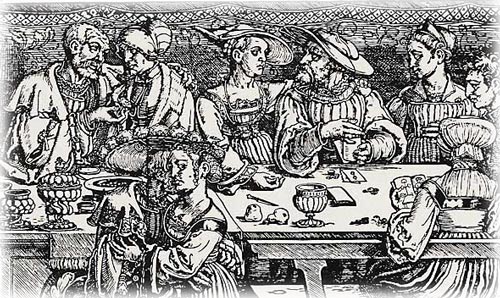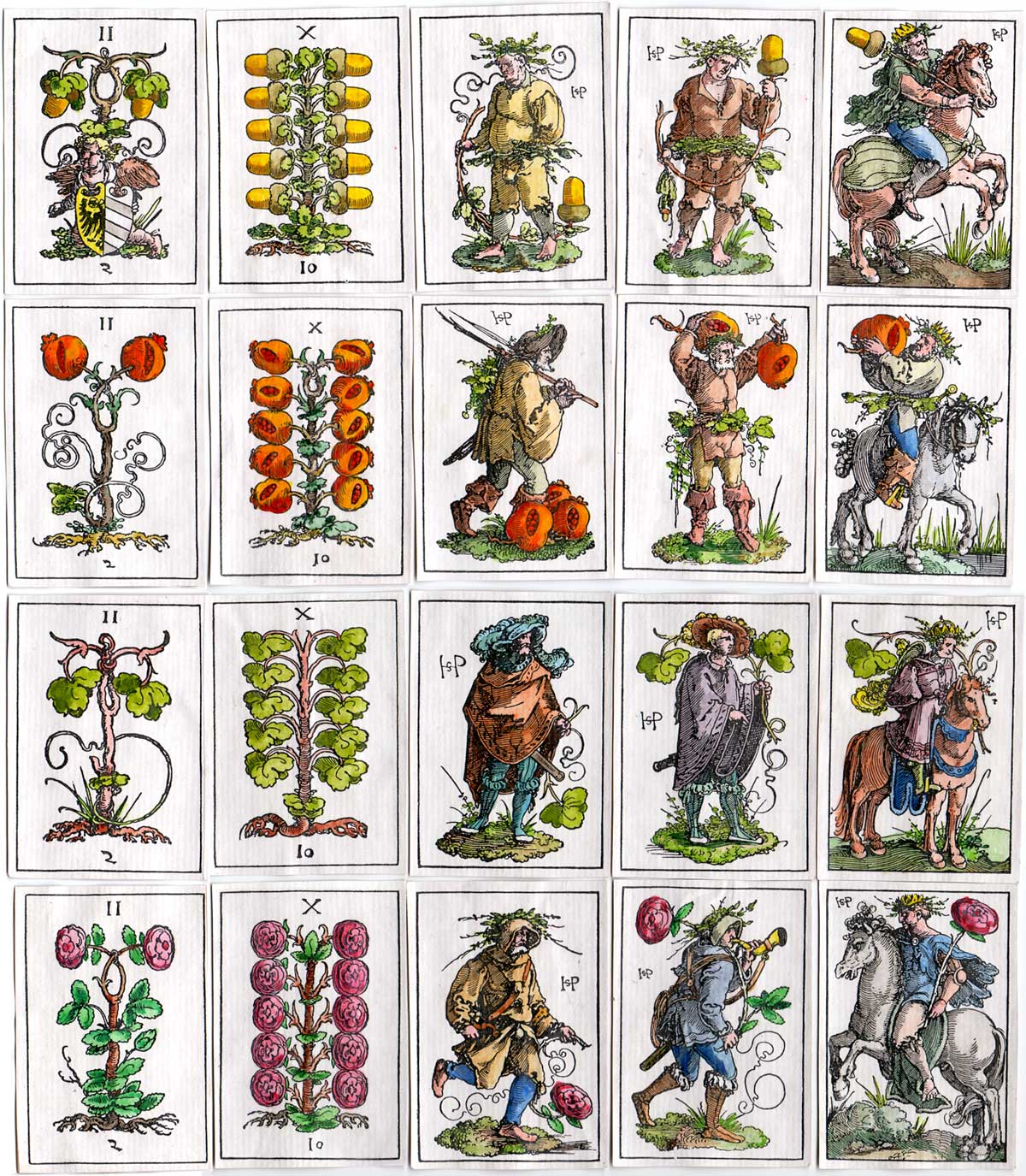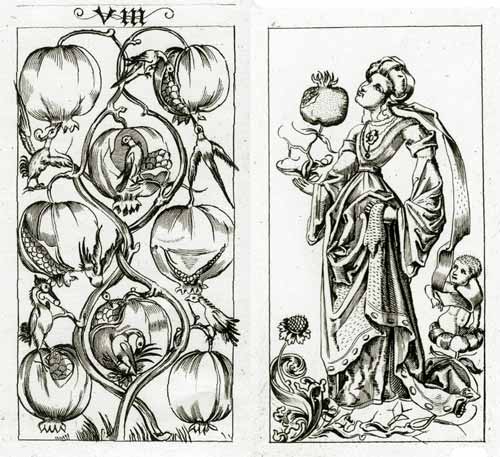Hans Sebald Beham
Playing cards designed by Hans Sebald Beham (1500–1550).

Hans Sebald Beham playing cards, c.1523
Hans Beham was born in Nuremberg in 1500. Tradition suggests that he received tuition from Dürer. He began his career in 1519 using the monogram H.S.P. and this pack of woodblock playing cards was produced when he was 23 years old. He continued to work in his home town until 1525 when he was exiled for heresy. He is next known at Frankfurt in 1531, having changed his monogram to H.S.B. He died in Frankfurt on November 22, 1550.



Above: cards from hand-made facsimile copy of the pack made from black & white outlines painted with watercolours, total 48 cards, 2014. The colours are not necessarily authentic. Size of original cards: 94x64 mm. The number cards have the suit symbols growing from a central trunk, and run from deuce (2) to 10 (without banners) which are index marked in Roman numerals at the top and Arabic numbers at the bottom. Apart from the three of acorns, there are no vignettes of country scenes or animals on the numeral cards.

Above: the pomegranate as a suit sign is also found in the latin-suited pack of cards by the South German Engraver (c.1496) which has 52 cards running from Ace to banner 10, female 'Sota', horseman and king. Many cards are decorated with young children or animals playfully cavorting between the suit symbols. In this case the suit sign of pomegranates probably alludes to the recently reclaimed kingdom of Granada.
The composition of the pack is deuce → ten, unter, ober and mounted king in each of the suits of acorns, pomegranates, leaves and roses. The deuce would have been the highest card as there were no aces. At this time the German suit-system was not yet standardised and packs are known with different systems involving everyday objects such as flowers, animals, birds, hunting equipment or coats of arms. Packs of the German suit system both with the values 1 → X and deuce → X are known. Mounted kings are also found on many sets of German playing cards into the 16th century.
The pomegranate as a suit sign is again found in the latin-suited pack of cards by the South German Engraver (c.1496) which has 52 cards running from Ace to banner 10, female 'Sota', horseman and king.
Some of the images from Hans Beham's cards were copied by other engravers from Nuremberg, in one particular case a latin-suited pack containing knave, cavalier and king.


By Simon Wintle
Member since February 01, 1996
I am the founder of The World of Playing Cards (est. 1996), a website dedicated to the history, artistry and cultural significance of playing cards and tarot. Over the years I have researched various areas of the subject, acquired and traded collections and contributed as a committee member of the IPCS and graphics editor of The Playing-Card journal. Having lived in Chile, England, Wales, and now Spain, these experiences have shaped my work and passion for playing cards. Amongst my achievements is producing a limited-edition replica of a 17th-century English pack using woodblocks and stencils—a labour of love. Today, the World of Playing Cards is a global collaborative project, with my son Adam serving as the technical driving force behind its development. His innovative efforts have helped shape the site into the thriving hub it is today. You are warmly invited to become a contributor and share your enthusiasm.
Related Articles

CARD-AB Miltenberg
Illustrations by Rita Stern depicting notable landmarks and scenes from the town of Miltenberg in Ge...

New Altenburg Skat cards – German DDR Pattern
Authentic Altenburger Skat cards with German suits (Acorns, Hearts, Leaves, Bells).

German Travel Cards
A travel-themed educational deck helping American tourists visiting Germany.

French Revolutionary cards by Pinaut
Seven cards from a French Revolutionary pack by Pinaut featuring characters from classical antiquity...

Tarot de las Coscojas
Historical playing card design, tarot symbolism and an almost psychedelic medieval surrealism.

Briefmarken-Quartett
Quartet game featuring postage stamps from the Zones of Occupation in post-WWII Germany.

IG Chemie Papier Keramik
Promotional pack designed by Karl-Heinz Schroers for a German trade union with comical bears on the ...

Engel-Tarot
Set of major arcana designed by Alois Hanslian depicting angels throughout.

Virgil Solis
Remarkable pack of 52 animal-suited playing-cards designed and etched by Virgil Solis.

Politiker-Skat by Bubec
Caricatures of world leaders, including many German politicians, by the artist Bubec.

Le Poker Politique
French politicians and various world leaders caricatured by the German artist Bubec.

Les Jeux de Pastor
Striking designs by Edouard Pastor focusing on the heads of figures from the medieval period.

Le Jeu des Personnages de l’Antiquité et du Moyen-Age
Edouard Pastor’s designs in black and gold inspired by Antiquity and the Middle Ages.

Rouen Pattern - Portrait Rouennais
An attractive XV century French-suited design from Rouen became the standard English & Anglo-America...

Grunwald 1410 – The Battle of Tannenberg
Details from the famous painting of the Battle of Grunwald (1410) by the Polish painter Jan Matejko....

Unimog UX 100
Cartoons promoting the Unimog UX 100, a small truck produced by Mercedes-Benz.
Most Popular
Our top articles from the past 28 days

